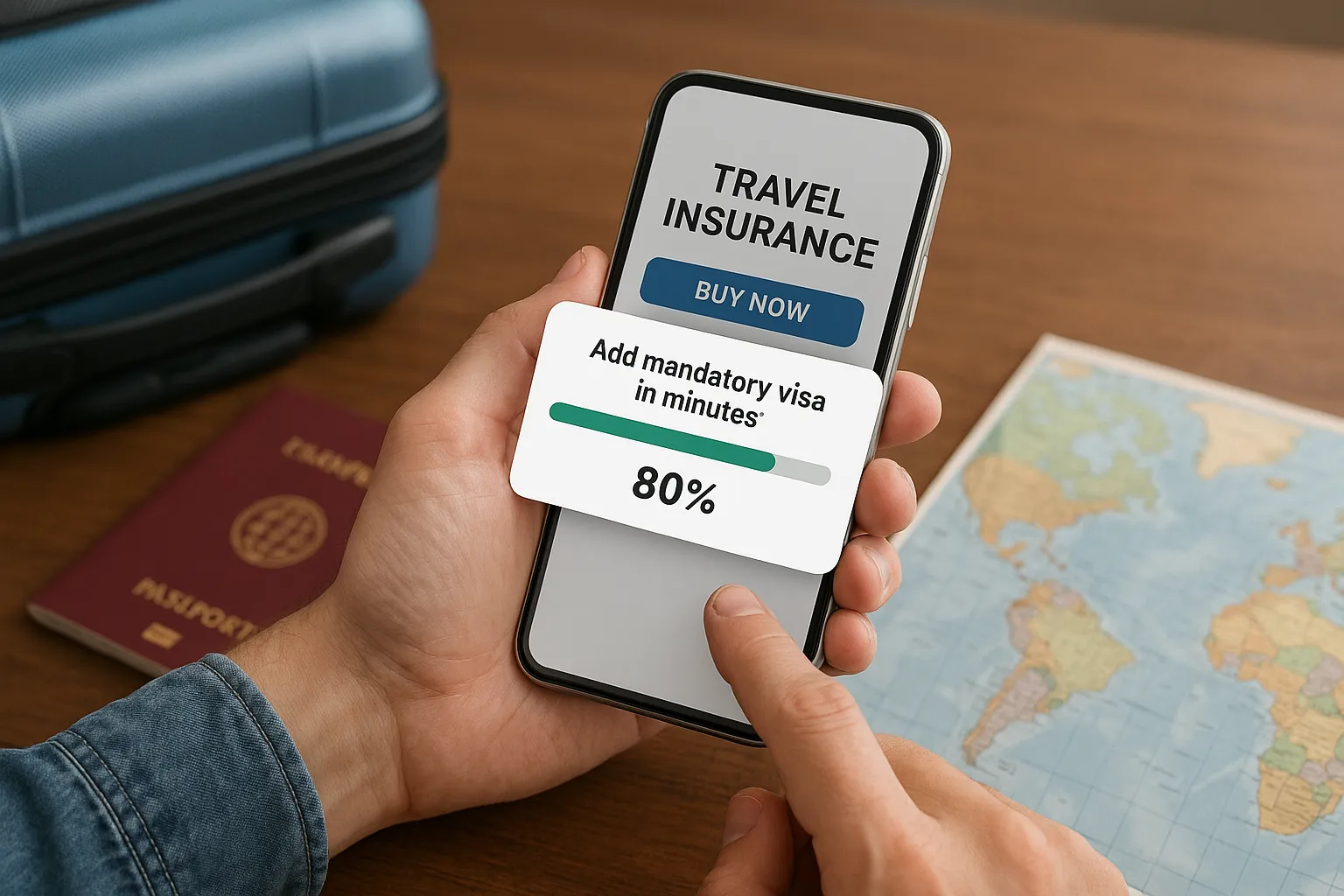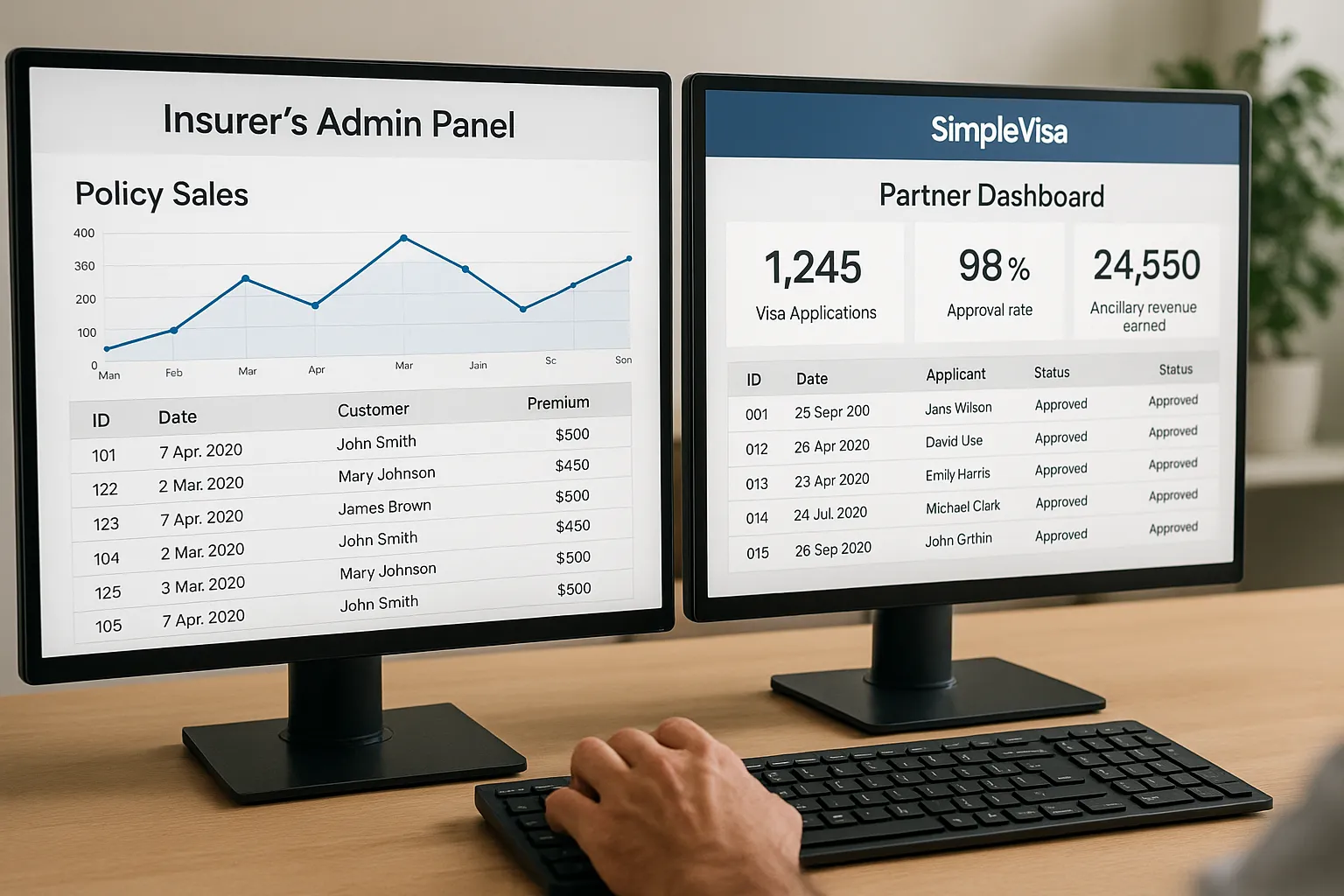How Travel Insurance Sellers Benefit from Embedded Visa Services

Travelers used to buy travel insurance, print their policy, and then open a new browser tab to figure out border entry rules by themselves. Today’s customers expect everything in one place – coverage, documents, and peace of mind delivered in two clicks. For travel insurance sellers, meeting that expectation is no longer a nice-to-have; it is table stakes for growth. The fastest route to that all-in-one experience is to embed visa services directly inside the insurance purchase flow.
Why the Timing Is Perfect
- Record international trips. The UNWTO projects global tourist arrivals will surpass 2019 levels in 2025, putting tens of millions of travelers back on the road.
- Visa complexity is rising. Nearly 50 countries have introduced new eVisa or Electronic Travel Authorization rules since 2020.
- Customers are digital-first. According to an Accenture travel survey, 74 percent of leisure travelers prefer to buy ancillary products, including insurance, online during the booking journey.
Travel insurance providers that remove the paperwork hurdle can surf all three waves at once.

What Are Embedded Visa Services?
Embedded visa services use an API or white-label widget to surface real-time entry requirements, eVisa eligibility, and an application form right where customers buy insurance. The provider (SimpleVisa, for example) automates:
- country-specific questionnaires
- document uploads
- fee collection and remittance to governments
- status notifications until approval
For insurers, the process feels like any other plug-and-play ancillary integration – similar to adding a rental-car offer or a flight delay add-on.
Six Business Benefits for Travel Insurance Sellers
1. Unlock New Ancillary Revenue Streams
Visa processing fees generate a healthy margin, especially when combined with premium services such as express handling or real-time application review. McKinsey estimates that ancillary products outside the core policy can boost average order value by 15 to 25 percent in travel insurance portfolios. Unlike price-sensitive coverage, visa fees are set by destination governments, so shoppers rarely price-compare between intermediaries.
| Revenue Lever | Typical Extra Margin | Why It Works |
|---|---|---|
| Standard eVisa processing | 15 – 20 USD per application | Government fee is fixed; travelers pay for convenience |
| Express / priority handling | +40 – 60 USD | Time-sensitive travelers value speed |
| Document translation | 10 – 30 USD | Niche but high-margin add-on |
2. Reduce Claim Ratios Through Compliance
Denied boarding, trip cancellation, and missed connections frequently stem from incomplete visas. An Allianz Partners study found that documentation issues accounted for 6 percent of all trip-cancellation claims in 2023. By shepherding customers through the correct visa application upfront, insurers can prevent those losses, improving combined ratios.
3. Differentiate the Customer Experience
Travel insurance is often perceived as a commodity. Offering an integrated visa solution turns a transactional purchase into a concierge-style service. When the insurance confirmation email also includes “Your visa was approved,” customer NPS scores spike – and renewal rates typically follow.
4. Capture Customer Data Earlier in the Journey
Visa applications require passport details, travel dates, and accommodation info that insurers usually collect only at claim time. With the proper consent framework, this structured data can power personalized cross-selling, fraud analytics, and dynamic pricing.
5. Cut Operational Overhead
Legacy call centers spend thousands of agent hours explaining entry rules. Embedded visa services offload that burden to automated workflows, freeing staff to focus on high-value tasks like medical assistance cases.
6. Future-Proof Regulatory Compliance
Digital visa providers continually update forms when governments change schemas or launch new security questions. Insurers avoid the risk of offering outdated advice – a critical factor as programs like ETIAS in Europe or eTA in Korea go live.
Integration Models at a Glance
| Model | Go-Live Time | Customer UX | Typical Use Case |
|---|---|---|---|
| API (fully embedded) | 4 – 6 weeks | Visa questions appear inside the insurance checkout | Large OTAs with in-house dev teams |
| White-label hosted app | 1 week | Branded visa portal opens in new tab or iframe | Mid-size brokers seeking speed |
| Data feed only | <1 week | Real-time eligibility checker, link out for application | Metasearch sites and quote engines |
SimpleVisa supports all three options, including a no-code widget that marketing teams can publish without developer resources.

A Hypothetical Case Study: GlobeSure Travel Insurance
Before integration:
- 0 USD visa revenue
- 18 percent of trip-cancellation claims linked to documentation problems
- Customer satisfaction score 7.1 / 10
After embedding SimpleVisa’s API:
- Average of 1.3 visa applications sold per policy
- New ancillary revenue: 11 USD per policy on average
- Documentation-related claims down to 4 percent
- Customer satisfaction score up to 8.6 / 10 in six months
Implementation Steps
- Scope destinations: audit where your policyholders travel most often and identify visa-required markets.
- Choose an integration path: API for fully embedded flows, white-label for rapid MVP.
- Map customer journey touchpoints: quote page, confirmation email, policyholder portal.
- Configure compliance and revenue share terms.
- Pilot with a single market, measure conversion, then scale.
For deeper technical insight, see our guide on How eVisa APIs work: Step by Step.
Key Questions to Ask a Visa Platform Vendor
- What is the documented visa approval rate?
- How often is country content updated?
- Do you handle government fee collection and reconciliation?
- Can we white-label the customer notifications?
- What reporting tools track ancillary revenue in real time?
Conclusion: A Win-Win Add-On Ready for 2025
As international mobility rebounds, travelers will continue to juggle insurance, health declarations, and visa rules. Embedding visa services allows insurers to solve two headaches at once – lowering risk and lifting revenue – while delivering the friction-free journeys customers demand.
SimpleVisa already powers automated visa processing on more than 400 travel sites. If you are ready to turn every policy sale into a one-stop border-compliance package, visit our Visa Management Platform overview or book a demo to explore integration options tailored to your distribution model.